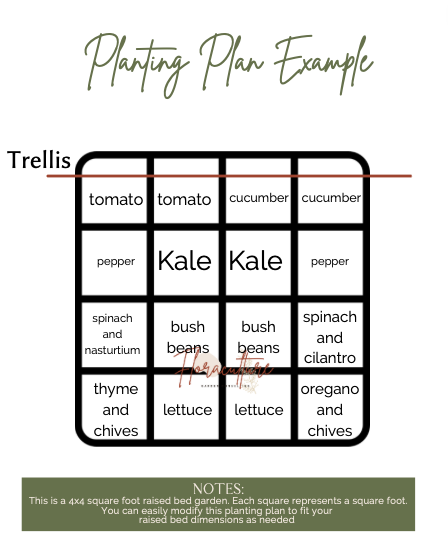How to Maximize Your Backyard Garden Space
After creating a list of what you want to grow for the year and what season you will grow everything in, step two is figuring out where everything will go.
Wondering how to plant your raised beds so that they look like this?
enter….. THE PLANTING PLAN!
This is the step that will tell you HOW MANY of each vegetable you can grow.
For EACH SEASON (in Michigan we have cool 1, warm, cool 2) do the following:
1- Start by making a drawing of the square footage of your beds. For example, my raised beds are 6x2 so I will draw rectangles with 12 squares inside
2 - add the location of permanent fixtures to your beds. This includes support structures like a trellis, as well as perennials that already occupy planting space. For me, this includes peppermint and lavender.
3- now start assigning space for each plant you want to plant. Large plants will get their own squares, while medium and small plants can share! I teach my clients how to plant intensively like this because it is truly to key to a productive vegetable garden, and it also requires a raised bed to do it. Lastly, be sure to carry over any plants that will persist between seasons. Kale, will persist through summer and the cooler seasons while the space you give to cucumbers is just for the warm season.
Below is an example of a planting plan! When you make your own, be sure to include the quantity of plants needed, as well. For example, I have two squares listing cucumber but I will be planting 2 plants in each square - so the total number of cucumber plants I will need is 4.
I do this for all of my beds, for every season. Prior to doing this I would have so much empty soil space! It was such a waste. Now I know that in two squares of my beds I will fit 6 celery plants (and a handful of carrots) so that’s how many I plan for to start from seed. Previously I would plan for 1-2.
And that’s it! A little bit of planning goes along way, take the time to draw it out and keep the plans for the whole year. Come March, May, and September when you are changing your beds over for each season you will want to reference them.
When backyard gardening, we have a definitive amount of space that we can work with so learning how to make the most of it can really take your gardening to new heights.



